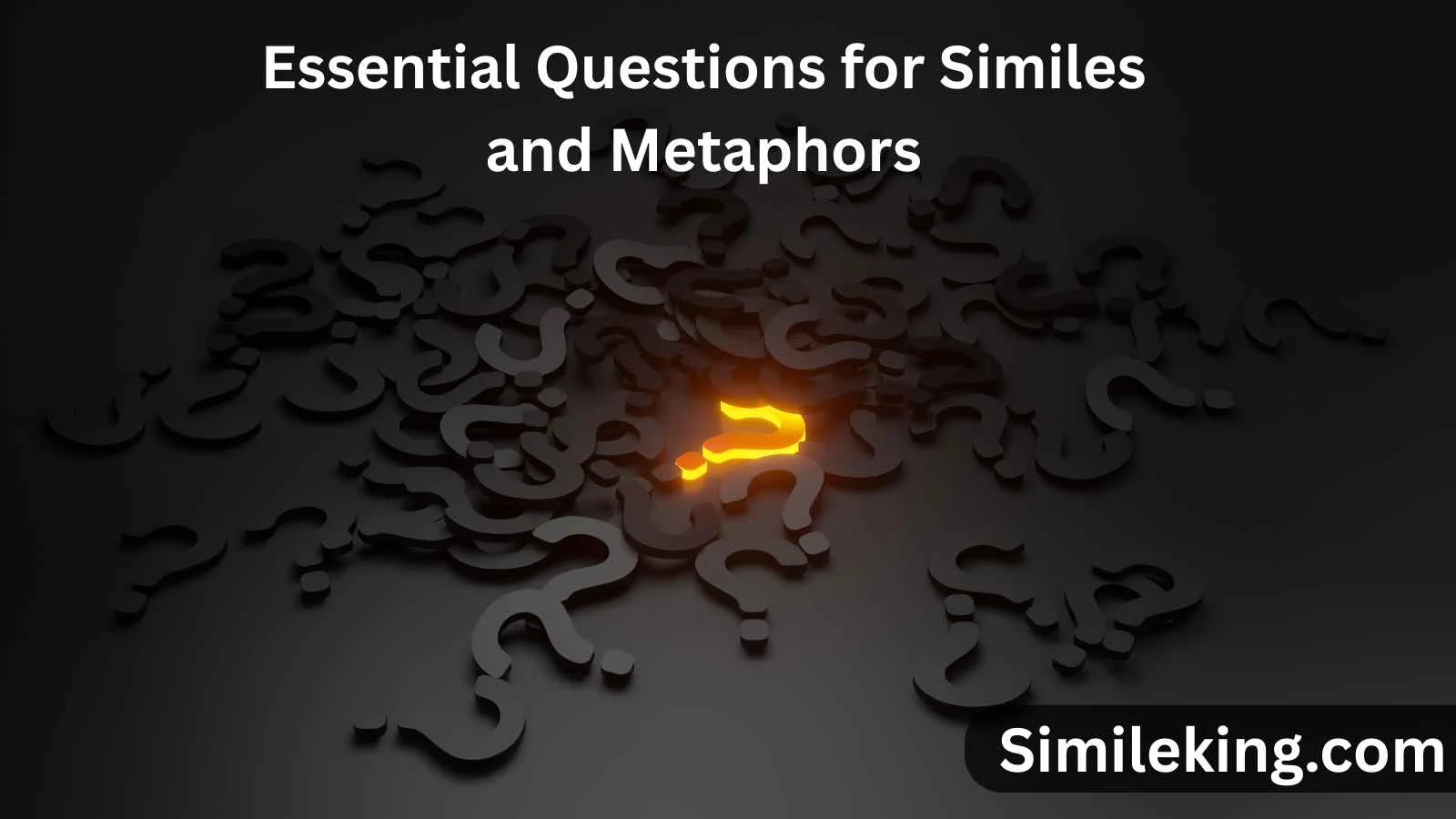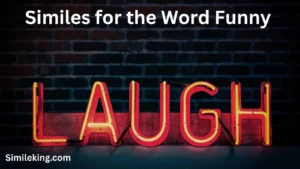Similes and metaphors are the heartbeat of vivid communication. Whether you’re crafting poetry, teaching a classroom of eager students, or writing content that resonates, understanding how to ask about similes and metaphors is just as important as knowing how to use them.
This article dives deep into 25+ essential questions for similes and metaphors, examining the nuances behind each query. You’ll discover ways to approach these questions in polite, professional, and casual tones, ensuring your language adapts smoothly to different settings—be it academic writing, creative discussions, or texting.
We’ll also include 8 optimized texting examples to make this guide practically helpful and Google-friendly.
Why Are Essential Questions Important in Figurative Language?
Before exploring the specific questions, it’s important to understand why essential questions matter:
- They guide learning. In classrooms, essential questions help students critically think about language.
- They spark creativity. For writers, these questions act as prompts that unlock new metaphors.
- They clarify tone. In conversations, questions about similes/metaphors reveal intent and help avoid misunderstandings.
- They bridge knowledge levels. Whether a 5th grader or a college student, these questions scale to meet the learner where they are.
Tone Matters: Polite vs. Professional vs. Casual
When asking questions about similes and metaphors, your tone affects clarity and engagement. Here’s how tone alters the approach:
| Tone | Example | Context |
|---|---|---|
| Polite | “Could you explain the metaphor used in that sentence?” | Academic discussions |
| Professional | “How does this metaphor enhance the overall message?” | Meetings, essays, editorial |
| Casual | “What’s that line supposed to mean?” | Texts, friendly chats |
Now let’s break into the core of this guide: the 25+ essential questions grouped by context, tone, and purpose.
Section 1: Foundational Questions for Beginners
These questions are best for learners or casual discussions. They invite explanation and introduce basic concepts.
1. What is a simile?
Polite version: “Could you clarify what a simile is?”
Professional: “How would you define a simile in literary terms?”
Casual: “What even is a simile?”
2. What is the difference between a simile and a metaphor?
This is foundational to avoid confusion.
Example: “Isn’t ‘like’ or ‘as’ only for similes?”
3. Why do authors use similes?
Encourages deeper reading.
Professional: “What function does this simile serve in the text?”
4. Can a metaphor be used in formal writing?
This helps identify context-sensitive language.
5. Are metaphors always poetic?
Discussions on tone and use in speeches, news, etc.
Section 2: Interpretation-Based Questions
Use these to explore the meaning behind figurative language.
6. What does this metaphor suggest about the character’s mindset?
Perfect for literary analysis.
7. How does this simile connect to the theme?
Encourages critical thinking.
8. Is this metaphor literal or symbolic?
Helpful for ESL learners or students new to figurative expression.
9. What image does this simile create in your mind?
Invites visual imagination—great for creative writing classes.
10. Could there be a better metaphor for this idea?
Encourages revision and creative thinking.
Section 3: Tone & Intent Behind Figurative Language
These questions help uncover how metaphors affect tone.
11. Does the metaphor make the tone more emotional?
Professional: “What emotional layer does this figurative language add?”
12. How would removing the simile change the sentence?
Focuses on necessity and effect.
13. Is the metaphor exaggerating or simplifying the concept?
Great for persuasive and political writing.
Section 4: Crafting and Using Similes & Metaphors
These are practical, use-based questions for writers and students.
14. How do I write a metaphor without using “like” or “as”?
Teaches metaphor construction.
15. Can I mix metaphors in the same paragraph?
Avoiding cliches and mixed meanings.
16. How do I know if my simile is original?
Fosters creative integrity.
17. What makes a metaphor powerful or weak?
Discussion of imagery, tone, clarity.
18. Are metaphors cultural or universal?
Highlights the nuance of context and audience.
Section 5: Teaching Similes and Metaphors
These questions are tailored for educators, lesson planning, and student engagement.
19. How can I explain metaphors to 5th graders?
Texting version: “Any easy way to explain ‘metaphor’ to kids?”
20. What are good classroom activities for similes?
Professional tone: “What interactive methods best teach simile recognition?”
21. How can I test if students understand metaphors?
Formative assessment strategies.
22. Should similes be taught before metaphors?
Sequencing concepts for curriculum planning.
Section 6: Digital Communication and Figurative Language
Even in texting and memes, figurative language matters.
23. Is using metaphors in texts confusing?
Casual: “Am I being too poetic here?”
24. Can emojis replace similes or metaphors?
Fun question with serious implications.
25. How do social media captions benefit from metaphors?
Professional version: “Can metaphorical phrasing increase engagement?”
26. Can AI tools help me create similes?
Helpful for bloggers, students, or marketers using writing assistants.
8 Optimized Texting Examples (User-Friendly + Google Optimized)
These examples combine real-life communication with SEO-smart structuring.
- “I’m feeling like a balloon about to pop 🎈—is that a simile or just drama?”
- ✅ Fun, casual, optimized for “simile vs. metaphor” keywords
- “What’s that line ‘her eyes were stars’? Is that a metaphor?”
- ✅ Directly targets “identify metaphor” search queries
- “Can you help me write a poetic simile for sadness?”
- ✅ Includes “simile for sadness,” a common student search
- “This metaphor makes no sense to me. What’s it really trying to say?”
- ✅ Engages “analyze metaphor meaning”
- “Is it okay to use a simile in a college essay?”
- ✅ Targets “can I use similes in academic writing”
- “How do I make my metaphor sound less cheesy?”
- ✅ Includes “improve metaphor writing” intent
- “Quick—what’s a good simile for being super tired?”
- ✅ Fits “simile for tired” keyword and search pattern
- “I wrote ‘like a storm in a teacup’—is that cliché?”
- ✅ Optimized for “cliché similes or metaphors” queries
Choosing the Right Question for the Right Moment
Different conversations demand different approaches. Here’s a breakdown:
| Audience | Ideal Tone | Sample Question |
|---|---|---|
| Classroom Students | Polite | “How does this simile describe the scene?” |
| Academic Discussion | Professional | “What symbolic meaning does this metaphor carry?” |
| Friends/Peers | Casual | “So…is this just a fancy way of saying he’s angry?” |
| Writers’ Workshop | Mixed | “Is this metaphor fresh or overused?” |
| Online Forums | Friendly | “Any examples of funny similes I can borrow?” |
Conclusion: Why These Questions Matter
Asking the right questions about similes and metaphors helps us:
- Think more deeply about language
- Write with precision and beauty
- Understand the emotions behind words
- Connect with readers and listeners
Whether you’re teaching, learning, writing, or texting, these 25+ essential questions serve as your go-to toolkit for mastering figurative language. The more curiosity you bring to language, the more powerful your communication becomes.





